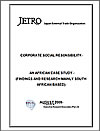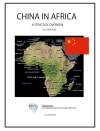 Eramet Comilog
Eramet Comilog
All data are collected in the Fiscal Year of 2008-2009.
Company Profile and History
Eramet is a rapidly growing French mining and metallurgical group. Eramet Comilog Manganese is currently the world's 2nd-largest producer of manganese alloys for steelmaking, with plants in Europe, North America and China. The division is also the world’s leading producer of manganese-based products for the chemicals industry which are used in a wide range of applications, such as electric batteries, ferrites, fertilizer, animal feed, etc. Eramet is listed on Euronext Paris, where its shares are traded under the deferred settlement system. It is listed in Compartment A and on the CACNext 20 and CAC Mid 100 index.
The Company was created under the name Le Nickel in 1880, originally for the exploitation of nickel mines in New Caledonia. Under the majority control of the Rothschild family since the end of the 19th century, in the late 1960’s it became the parent company of all the Rothschild group’s mining subsidiaries (Le Nickel-Penarroya-Mokta group). In 1974 Le Nickel changed its name to Imétal. In 1983 as part of an industrial, shareholding and financial restructuring programme, ERAP, a French state-owned company, acquired a 70% interest in the Company’s capital.
In 1985 the assets located in New Caledonia were grouped together in Société Métallurgique Le Nickel-SLN, a wholly-owned subsidiary of a new parent company called Eramet-SLN, in which the shareholders was 70% ERAP, 15% Imétal and 15% Elf Aquitaine. In 1992 Société Métallurgique Le Nickel-SLN and Eramet-SLN took on their current names of Le Nickel-SLN and Eramet, respectively.
In 1995/6 Eramet acquired a 46% stake in Comilog (Gabon), the world’s second-largest producer of high-grade manganese ore and a leading global producer of ferromanganese for the steel industry and manganese-based chemicals. In 1997, in an agreement with Gengabon, the Gencor group company sold Eramet a 15% stake in Comilog.
Comilog has two major bases in Gabon: the Moanda manganese mine and sintering plant; and the Owendo sea port and logistics site. Comilog also manages Setrag, the company that runs the Transgabonais railway.
In November 2005, Comilog obtained the concession for the ‘Transgabon’ railway for a period of 30 years, which is strategic for the group, since it allows it to secure the transportation of ore between the mine at Moanda and the port of Owendo, thus guaranteeing the ramp-up of manganese ore production to 3.5 million tonnes a year.
The 684 km Transgabonais railway (TG), built as a high-quality standard-gauge line with 25 tonne axle load between 1974 and 1986, connects the port of Owendo, near Libreville, with Franceville, in the interior. Although it carries both general freight and passengers, its primary traffics are manganese ore (65 percent) and logs (20 percent).
In Country Location
Compagnie Miniere de l’Ogooue SA, BP 578, Port Mineralier d'Owendo, 5PMO; Gabon
Telephone: +241 70-2261
Telefax: +241 74-2337
Services and Products
Comilog mines and enriches ore and produces sintered ore for the steelmaking market
Number of Employees
2,800 employees in Gabon
Financial Information
The three divisions of the Group-Eramet Nickel, Eramet Manganese and Eramet Alloys-generated a combined €4.346 billion in turnover in 2008
Turnover by main market in 2008
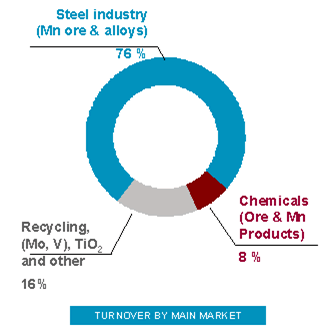
Current operating income (in millions of euros)
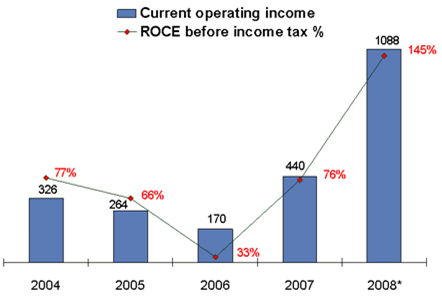
Gabon statistics

Market Share
Gabon has the second largest deposit of manganese in the world and is currently the world’s third largest producer. COMILOG is the only company currently producing manganese in Gabon.
Business Objective
“To give new impetus to the growth of the Group and to take it beyond its existing borders, whether these be geographical, individual, collective or technical”
Business Model
“The Group is engaged in a plan for profitable, lasting and harmonious growth. Eramet’s strategy aims to: develop and strengthen its global leadership positions in each of its activities, owing to an investment policy combining the extension of very competitive capacity, internal development and external growth operations; establish its position in speciality products, with higher added value, underpinned by dynamic, innovative and customer-focussed R&D; maintain its activities at the highest level of international competitiveness accompany the geographical expansion of its customers and its markets, both by extending its own commercial network and by establishing new industrial sites; and expand the range of products it offers to its major customers.”
Ownership of Business
Shareholding as on December 31st, 2008
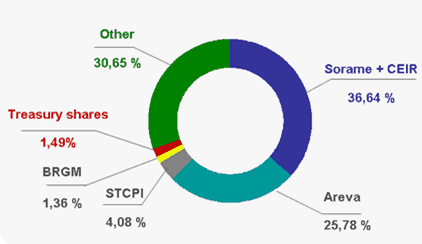
BRGM: Bureau de Recherches Géologiques et Minières (French State) STCPI: Société Territoriale Calédonienne de Participation Industrielle (New Caledonian provinces)
Comilog is 25 percent owned by the state and 65 percent by Eramet.
Benefits Offered and Relations with Government
The Ministry of Mines, Energy, and Petroleum has exclusive rights to grant prospecting, exploration, and mining permits. All useful minerals under the surface are the property of the state. The state maintains a partial stake in most of the mining sites in partnership with French, Canadian, Danish, and Chinese companies through smaller state-controlled companies.
Gabon’s mining sector is characterized by: (i) a restrictive mining code with cumbersome procedures and discretionary powers; (ii) a complex and inefficient titling system; (iii) contradictions in the fiscal terms between various legal and contractual documents; (iv) inexistent environmental management plans; (v) absence of a structured mechanism for sharing revenues with local communities; (vi) insufficient geo-scientific data base and limited promotional capabilities; (vii) an obsolete institutional set up with unclear and sometimes overlapping responsibilities, and understaffed departments.
Since 2001, the country’s officials have adopted a Mining Policy Statement in accordance with the National Economic Policy (PEN), which aims at diversifying the economy through mining, the timber industry, fishing and tourism with no participation from the State in commercial operations.
The Mining Policy Statement aims at increasing profit in the mining sector by the diversification of the operators and the substances exploited. The State has reaffirmed its desire to create conditions favourable to the development of the mining sector that takes the best international practices into account. According to its strategy, the State has given the private sector the mission of developing the Gabonese mining industry, whereas the Government will focus on establishing basic infrastructures, creating a climate open to investment, promoting the sector and defining a legal and institutional framework that will promote the rigorous application of regulations.
The Fiscal Regime
Mining rights: they include (1) a fixed fee, (2) a surface occupation fee, and (3) a value-added tax that varies between 0.5% and 5% per year; Fiscal charges: they are small and their amount varies according to the permit type (exploration or mining) and, for the mining phase, to the stage of operation (investment or production); Corporate tax: it amounts to 35% after special exemptions (e.g. accelerated depreciation). Import duties: they do not apply during the exploration and investment phases and exclude all consumables used during processing and there is no export tax
Product Development
In April 2009 former president Omar Bongo laid the first stone for the future Monad Metallurgical Complex. The planned project consists of a silico-manganese plant with 65,000 tons annual capacity and a 20,000-ton per year manganese metal plant, as well as the related infrastructure. The development of the Metallurgical Complex is concomitant with the upgrading of the public electricity grid, including the Gabonese government’s construction of a “Grand Poubara” hydroelectric power plant on the Ogooué River.
The Comilog 2010 project to extend production capacity to 4 million tons was finalised in 2008 and implementation began. In parallel, renovation work on the Transgabonais railway made progress: 30 km of track was changed as planned and 60,000 new sleepers were laid, in excess of the target.


